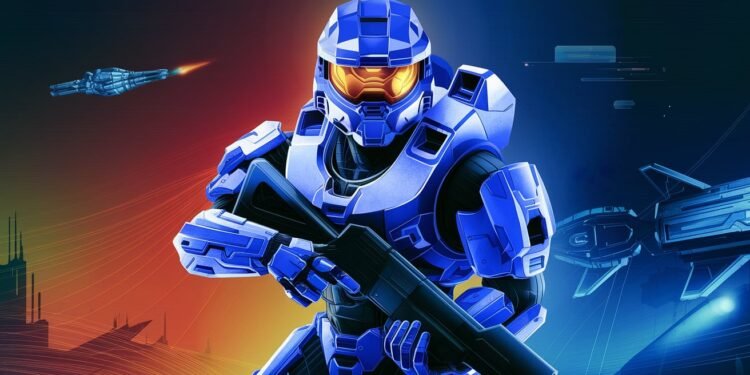Contents
Introduction to Halo (2003) Game Icons Banners
halo (2003) game icons banners The release of the original Halo game in 2001 marked a pivotal moment in the realm of video gaming, establishing itself as a cornerstone of the first-person shooter genre. Developed by Bungie and published by Microsoft, Halo: Combat Evolved not only introduced innovative gameplay mechanics but also became a cultural touchstone for gamers around the globe. This game set the foundation for an expansive franchise, which has since evolved into a major player in the industry, encompassing novels, comics, and a multitude of sequels. Central to the franchise’s enduring legacy are the Halo (2003) game icons banners, which serve as identifiers and promotional materials that resonate with fans and newcomers alike.
The significance of these icons and banners transcends mere aesthetics. They encapsulate the essence of the Halo universe, representing iconic characters, memorable quotes, and pivotal moments that have shaped the gaming experience. Game icons often symbolize a player’s achievements and provide a sense of belonging within a larger community. These visuals not only enhance user engagement but also act as critical marketing tools that help draw new players into the unparalleled narrative of the Halo series.
As we delve deeper into the evolution of Halo game icons banners, it becomes evident how they reflect shifts in communication within the gaming community. The intertwining of visual identity and community engagement underscores the importance of these designs in fostering a rich, interactive environment for fans. Through various iterations and adaptations, the Halo franchise has continuously reinvented its icons and banners to remain relevant and appealing amidst the ever-changing landscape of gaming popular culture.
Design and Aesthetics of Halo (2003) Game Icons Banners
The design and aesthetics of the Halo (2003) game icons banners reflect a carefully crafted visual identity that became emblematic of the franchise. A primary visual element is the color scheme, which predominantly utilizes a palette of muted greens, grays, and blues. These colors not only enhance the military and science fiction themes of the game but also evoke a sense of depth and atmosphere, drawing players into its universe. Complementary colors, occasionally splashed across the banners, serve to highlight key characters and objects, adding a dynamic quality to the overall design.
Typography plays a significant role in the visual aesthetic of Halo (2003) game icons banners. The choice of typeface is bold and sharp, embodying a sense of urgency and action that aligns with the gameplay experience. The lettering often features angular forms that resonate with the game’s futuristic elements. This stylistic choice ensures that the text remains legible while contributing to the overall sci-fi motif. Furthermore, the incorporation of logos and other graphic motifs reflects the game’s identity, allowing players to instantly recognize the Halo universe.
During the early 2000s, graphic design trends leaned towards a blend of realism and minimalism, and the Halo (2003) game icons banners are no exception. The use of high-quality images, combined with subtle gradients and textures, exemplifies the digital artistry of the time. The emphasis on clean lines and sharp contrasts aligns with the broader trends in video game marketing, aimed at capturing the attention of a rapidly growing audience. These artistic choices collectively establish an enduring visual language that resonates with both new players and nostalgic fans, ensuring that the legacy of the Halo (2003) game remains pronounced.
![]()
Cultural Impact and Community Engagement
The Halo (2003) game icons banners have significantly contributed to the cultural landscape of the gaming community, serving as visual symbols that resonate deeply with fans. These iconic banners are frequently utilized in promotional materials, enhancing the marketing strategies of the franchise and fostering a sense of excitement among gamers. By featuring memorable imagery and characters, they evoke nostalgia, allowing players to relive their experiences and connect with others who share similar sentiments.
Additionally, the effectiveness of these banners extends beyond mere promotional purposes. As players engage with the Halo community through fan art and social media, the game icons banners often feature prominently, symbolizing individual and collective identities. fan artists routinely reinterpret these icons, creating unique artwork that reimagines the characters and themes that have inspired them. This creative expression not only enhances their personal connection to the game but also fosters a sense of belonging within the community.
Social media platforms have further amplified the reach of these icons. Players regularly share their favorite banners, discuss their meanings, and engage in conversations about the Halo universe. This exchange cultivates a vibrant culture where fans feel empowered to express their passions and forge connections with people near and far. Examples of fan interactions abound, from cosplay recreations inspired by game icons to forum discussions analyzing the narrative depth represented through these visuals.
In recognition of their significance, various gaming events and conventions often celebrate Halo’s impact through exhibitions of fan art, merchandise, and panels discussing the franchise. These gatherings serve as a testament to the lasting impressions of the Halo (2003) game icons banners and reinforce their role as integral components of the gaming community’s identity.
The Legacy of Halo (2003) Game Icons Banners Today
The legacy of Halo (2003) game icons banners remains profoundly impactful within contemporary gaming culture. Since their introduction, these banners have evolved significantly in design, serving as not only promotional tools but also as cherished symbols of the community surrounding the franchise. The distinctive style of Halo’s visual language has influenced countless other games, prompting designers to create similarly compelling icons and banners that capture the essence of their narratives and gameplay experiences.
One of the most notable advancements in the design of these banners has been the shift towards high-resolution graphics and dynamic elements. Modern technology has allowed developers and artists to create vibrant and intricate imagery that resonates with both longtime fans and new audiences. Digital platforms have also played a crucial role, enabling the rapid dissemination and sharing of these visuals. Social media, in particular, has transformed how players interact with game icons and banners. Users readily share their favorite designs, fostering a community that continuously engages with Halo’s rich heritage.
This ongoing interaction illustrates the game’s lasting influence on newly developed franchises. Many contemporary titles draw inspiration from Halo’s aesthetic, leading to the emergence of recognizable game icons that also serve to create a sense of nostalgia. Moreover, fan engagement remains high, with communities participating in the creation and sharing of fan art that pays homage to the original Halo (2003) game icons banners. By nurturing this creative environment, developers not only solidify their game’s legacy but also cultivate a bond with their audience.
halo (2003) game icons banners In conclusion, the legacy of Halo’s iconic aesthetics transcends generations, with modern innovations driving the creation and appreciation of game icons and banners. The blend of technological advancements and fan involvement ensures that the spirit of Halo continues to thrive in the gaming landscape.




